A Method to Minimize the Effort for Damper–Blade Matching Demonstrated on Two Blade Sizes
Abstract
1. Introduction
- It seals the high temperature gas stream from the blade root cooling air.
- It provides friction damping.
- It serves as an elastic constraint between adjacent blades.
- representing the kinematics of the platform by means of the displacements and the rotations of just one appropriate single point allows all the nonlinear contact forces distributed on the underplatform/damper interfaces to be represented by means of the “dynamically equivalent” concentrated forces and moments applied at that point;
- modeling the neck by means of beams represents the reality in its most simple, straightforward and time-honored way, and is fully compatible with the advantages of describing the kinematics of cross-sections (of neck and platform) in terms of a single point displacements and rotations;
- the airfoil CMS reduction is performed only once, as the airfoil is kept constant during optimization calculations.
2. Method
2.1. Model
- the neck is represented through a series of beam elements;
- the platform, due to its size and shape behaves as a rigid body, in particular regarding the kinematic relationship between its central point P and its contact points with the dampers (see Figure 1);
- although it is sure that points R and N are connected rigid body kinematics and equilibrium, it is expedient here to represent the platform as a series of two beams;
- this modeling choice allows the beam area moments of inertia to be adjusted in such a way that local contributions to elastic deformabilities at the airfoil–platform junction (point R) and at the neck–platform junction (point N) are correctly taken into account [24].
2.2. Proof of Accuracy
2.3. A Worked-Out Example of Application
- Stick/Microslip: the resonance frequency is close to , the (low) hysteretic damping prevails and the stress levels are growing ≈ linearly with .
- Gross Slip: the resonance frequency is lower than but still higher than . This is the preferred working condition, dominated by friction and not by hysteretic damping. The stress levels still increase with a constant rate; however, the slope of the curve is significantly lower if compared with the one detected at regime 1.
- Advanced gross slip: the resonance frequency is close to as the damper slides freely between the platforms for the majority of the period of vibration. At the level of a single contact point, it can be observed that the distance traveled by the damper with respect to the platform in stick condition is negligible (i.e., lower by more than one order of magnitude) with respect to the distance traveled in slip. In this condition, friction becomes incapable of dissipating the input energy, as already observed by [27]. This regime is once again dominated by hysteretic damping, which is typically low. As a result, the slope of the starts increasing exponentially. It can be argued that the higher the value of this limit value, the better the matching between blade and damper.
2.4. A Priori Estimate of the Excitation Limit Force
- is the area within the hysteresis cycle shown in Figure 6b;
- is an efficiency coefficient < 1 due to the fact that, unlike the Den Hartog case, the cycle area is reduced due to the non-infinite stiffness of the tangential contact; however, at resonance, the gross-slip part prevails and .
3. The Test Cases
4. Representation and Interpretation of Results
- the neck length is assigned the values (20,30) mm to explore the influence of neck flexibility, which bears on the blade mode shape; it is worth noting that the stiffness and mass matrices of the PCR blade are parametrically linked to , and no re-meshing procedure is required;
- the centrifugal load on the damper is assigned its nominal value and ; the 0.5 scaling factor is compatible with a realistic 50% reduction of the mass of the damper (e.g., by removing the lower portion not in contact with the blades) or with a 30% reduction of the disk rotational speed.
- For both blades A and B, a longer, more flexible, neck is always beneficial: the limit “proof” excitation force is higher and the maximum fatigue bending stresses are lower than in the case of a shorter neck through the whole span. This is mainly due to the fact that the ratio is larger (i.e., the platform rotation is larger for the same displacement at the excitation point) when the neck is more flexible. In the present case, the values of this ratio range from 2.5 to 3.5 for blade A, from 0.8 to 1.3 for blade B. It must be remembered that the damper’s capability for In Phase blade vibration increases with the amount of rotation of the platform.
- The consequence of reducing the value looks more complex, due to the curve crossing, but is readily justified. In effect, since in full sliding all the forces are proportional to the value of , so are those of the frictional moment and of . Thus, with a reduced , the asymptote is reached earlier. However, on the other hand, regardless of , the initial full stick section on the curve is mostly determined by the stick constraint between damper and platform, which is independent on neck length. Since the first slip initiation in one of the contacts occurs for a lower contact force, the curve for smaller breaks off from full stick at a lower value than that for higher . This combination necessarily produces the intersection of curves.
5. Platform-Centered Reduction into the Larger Picture
6. Conclusions
- it is computationally inexpensive to change the shape and size of neck and damper and damper when exploring different design configurations (no remeshing required);
- the PCR runs in a fraction of the time needed for the customary Full FE nonlinear forced response calculation;
- the PCR’s synthetic representation makes it possible to easily observe the presence of an excitation limit force beyond which the damper becomes ineffective and to predict its value through a simple formula;
- once contact forces have been calculated with the PCR, they can be fed ex-post into the Full FE model excited with the corresponding force(s) and frequency, to allow the determination of all displacements and stresses with a straightforward linear solution.
- the ”Platform-Centered Reduction” is proved to be effective in offering indications to the designer on the most important trends and relationships between the design parameters and the performance of the system;
- the very fact of concentrating all nonlinearities in the rigid body DOFs of the platform makes it easy to draw attention to the essential: the interaction between the kinematics of the platform (+ neck) and the airfoil;
- the proposed representation of the outcomes of the procedure in terms of a “designer’s diagram” which shows maximum bending stress on the airfoil against excitation force at resonance proves to effective as an engineering development tool;
- by way of an engineering application in the design phase, this was demonstrated for two blade sizes showing the effect of varying both the neck length and the damper centrifugal force.
Author Contributions
Funding
Conflicts of Interest
References
- Griffin, J. Friction Damping of Resonant Stresses in Gas Turbine Engine Airfoils. J. Eng. Power 1980, 102, 329. [Google Scholar] [CrossRef]
- Szwedowicz, J. Cyclic Finite Element Modeling of Shrouded Turbine Blades Including Frictional Contacts. Volume 4: Manufacturing Materials and Metallurgy: Ceramics: Structures and Dynamics: Controls, Diagnostics and Instrumentation: Education: IGTI Scholar Award: General. In Turbo Expo: Power for Land, Sea, and Air; ASME: New York, NY, USA, 1999. [Google Scholar] [CrossRef]
- Sextro, W. The Calculation of the Forced Response of Shrouded Blades with Friction Contacts and its Experimental Verification. Volume 4: Structures and Dynamics. In Turbo Expo: Power for Land, Sea, and Air; ASME: New York, NY, USA, 2000. [Google Scholar] [CrossRef]
- Pourkiaee, S.M.; Zucca, S. A Reduced Order Model for Nonlinear Dynamics of Mistuned Bladed Disks With Shroud Friction Contacts. In Proceedings of the ASME Turbo Expo 2018: Turbomachinery Technical Conference and Exposition. Volume 7C: Structures and Dynamics, Oslo, Norway, 11–15 June 2018; ASME: New York, NY, USA, 2018. [Google Scholar] [CrossRef]
- Zucca, S.; Firrone, C.M.; Gola, M.M. Numerical assessment of friction damping at turbine blade root joints by simultaneous calculation of the static and dynamic contact loads. Nonlinear Dyn. 2011, 67, 1943–1955. [Google Scholar] [CrossRef]
- Pesaresi, L.; Salles, L.; Jones, A.; Green, J.; Schwingshackl, C. Modelling the nonlinear behaviour of an underplatform damper test rig for turbine applications. Mech. Syst. Signal Process. 2017, 85, 662–679. [Google Scholar] [CrossRef]
- Hüls, M.; von Scheidt, L.P.; Wallaschek, J. Influence of Geometric Design Parameters Onto Vibratory Response and HCF Safety for Turbine Blades With Friction Damper. Volume 7C: Structures and Dynamics. In ASME Turbo Expo 2018: Turbomachinery Technical Conference and Exposition; ASME: New York, NY, USA, 2018. [Google Scholar] [CrossRef]
- Petrov, E.P. Stability Analysis of Multiharmonic Nonlinear Vibrations for Large Models of Gas Turbine Engine Structures with Friction and Gaps. J. Eng. Gas Turbines Power 2016, 139. [Google Scholar] [CrossRef]
- Hartung, A.; Hackenberg, H.P.; Krack, M.; Gross, J.; Heinze, T.; von Scheidt, L.P. Rig and Engine Validation of the Non-Linear Forced Response Analysis Performed by the Tool OrAgL. Volume 7C: Structures and Dynamics. In ASME Turbo Expo 2018: Turbomachinery Technical Conference and Exposition; ASME: New York, NY, USA, 2018. [Google Scholar] [CrossRef]
- Fantetti, A.; Gastaldi, C.; Berruti, T. Modeling and Testing Friction Flexible Dampers: Challenges and Peculiarities. Exp. Tech. 2018, 42, 407–419. [Google Scholar] [CrossRef]
- Yang, B.D.; Menq, C.H. Characterization of Contact Kinematics and Application to the Design of Wedge Dampers in Turbomachinery Blading: Part 2—Prediction of Forced Response and Experimental Verification. J. Eng. Gas Turbines Power 1998, 120, 418. [Google Scholar] [CrossRef]
- Sextro, W. Dynamical Contact Problems with Friction–Models, Methods, Experiments and Applications; Habilitationsschrift, Lecture Notes in Applied Mechanics; Springer: Berlin/Heidelberg, Germany, 2002; Volume 3. [Google Scholar] [CrossRef]
- Gastaldi, C.; Gola, M. On the relevance of a microslip contact model for under-platform dampers. Int. J. Mech. Sci. 2016, 115–116, 145–156. [Google Scholar] [CrossRef]
- Armand, J.; Pesaresi, L.; Salles, L.; Schwingshackl, C.W. A Multiscale Approach for Nonlinear Dynamic Response Predictions With Fretting Wear. J. Eng. Gas Turbines Power 2016, 139, 022505. [Google Scholar] [CrossRef]
- Cardona, A.; Coune, T.; Lerusse, A.; Geradin, M. A multiharmonic method for nonlinear vibration analysis. Int. J. Numer. Methods Eng. 1994, 37, 1593–1608. [Google Scholar] [CrossRef]
- Grolet, A.; Thouverez, F. On a new harmonic selection technique for harmonic balance method. Mech. Syst. Signal Process. 2012, 30, 43–60. [Google Scholar] [CrossRef]
- Gastaldi, C.; Berruti, T.M. A method to solve the efficiency-accuracy trade-off of multi-harmonic balance calculation of structures with friction contacts. Int. J. Non-Linear Mech. 2017, 92, 25–40. [Google Scholar] [CrossRef]
- Krack, M.; Gross, J. Harmonic Balance for Nonlinear Vibration Problems; Springer International Publishing: Cham, Switzerland, 2019. [Google Scholar] [CrossRef]
- Baek, S.; Epureanu, B. Reduced Order Modeling of Bladed Disks With Friction Ring Dampers. In Proceedings of the ASME Turbo Expo 2016: Turbomachinery Technical Conference and Exposition. Volume 7A: Structures and Dynamics, Seoul, Korea, 13–17 June 2016; ASME: New York, NY, USA, 2016. [Google Scholar] [CrossRef]
- Gastaldi, C.; Zucca, S.; Epureanu, B.I. Jacobian projection reduced-order models for dynamic systems with contact nonlinearities. Mech. Syst. Signal Process. 2018, 100, 550–569. [Google Scholar] [CrossRef]
- Gastaldi, C.; Gola, M. Pre-optimization of Asymmetrical Underplatform Dampers. J. Eng. Gas Turbines Power 2016, 139, 012504. [Google Scholar] [CrossRef]
- Gastaldi, C.; Berruti, T.M.; Gola, M.M. The Relevance of Damper Pre-Optimization and its Effectiveness on the Forced Response of Blades. Volume 7B: Structures and Dynamics. In Turbo Expo: Power for Land, Sea, and Air; American Society of Mechanical Engineers: New York, NY, USA, 2017. [Google Scholar] [CrossRef]
- Gastaldi, C.; Gola, M.M. Criteria for Best Performance of Pre-Optimized Solid Dampers. ASME Turbo Expo 2018 Volume 7C: Structures and Dynamics. In Turbo Expo: Power for Land, Sea, and Air; ASME: New York, NY, USA, 2018. [Google Scholar] [CrossRef]
- Gastaldi, C.; Gola, M.M. Design Tools to the Best Coupling of Dry-Friction Solid Underplatform Dampers to Turbine Blades. Volume 7B: Structures and Dynamics. In ASME Turbo Expo 2019: Turbomachinery Technical Conference and Exposition; American Society of Mechanical Engineers: New York, NY, USA, 2019. [Google Scholar] [CrossRef]
- Gastaldi, C.; Gola, M.M. Platform-Centered Reduction: A Process Capturing the Essentials for blade–damper Coupled Optimization. J. Eng. Gas Turbines Power 2021, 143. [Google Scholar] [CrossRef]
- Sadhu, A.; Narasimhan, S.; Antoni, J. A review of output-only structural mode identification literature employing blind source separation methods. Mech. Syst. Signal Process. 2017, 94, 415–431. [Google Scholar] [CrossRef]
- Hartog, J. Forced vibrations with combined viscous and coulomb damping. Lond. Edinb. Dublin Philos. Mag. J. Sci. 1930, 9, 801–817. [Google Scholar] [CrossRef]
- Botto, D.; Lavella, M.; Gola, M.M. Measurement of Contact Parameters of Flat on Flat Contact Surfaces at High Temperature. Volume 7: Structures and Dynamics, Parts A and B. In ASME Turbo Expo 2019: Turbomachinery Technical Conference and Exposition; ASME International: New York, NY, USA, 2012. [Google Scholar]
- Zucca, S.; Epureanu, B. Bi-linear reduced-order models of structures with friction intermittent contacts. Nonlinear Dyn. 2014, 77, 1055–1067. [Google Scholar] [CrossRef]
- Mitra, M.; Zucca, S.; Epureanu, B. Adaptive Microslip Projection for Reduction of Frictional and Contact Nonlinearities in Shrouded Blisks. J. Comput. Nonlinear Dyn. 2016, 11, 041016. [Google Scholar] [CrossRef]
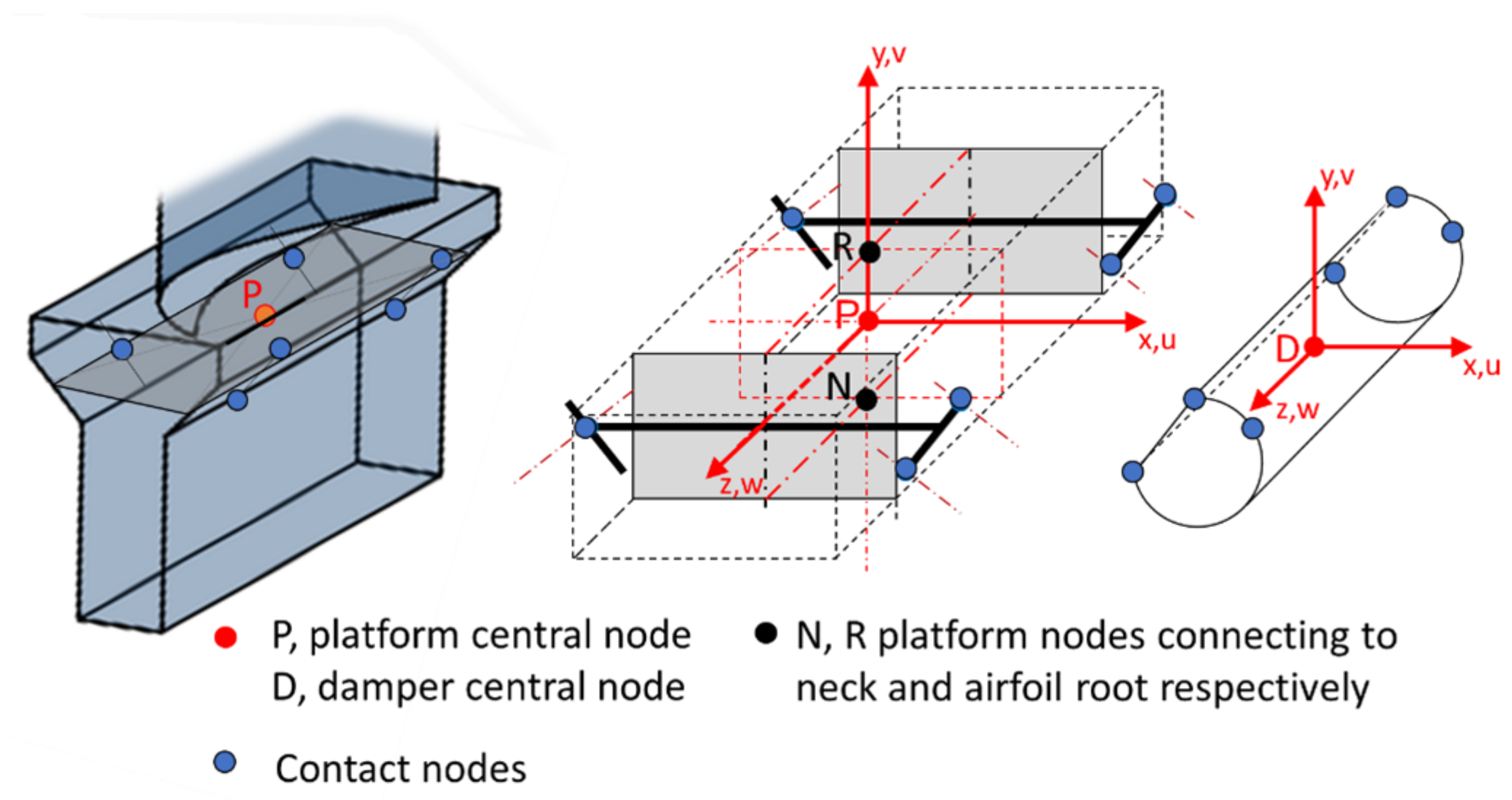
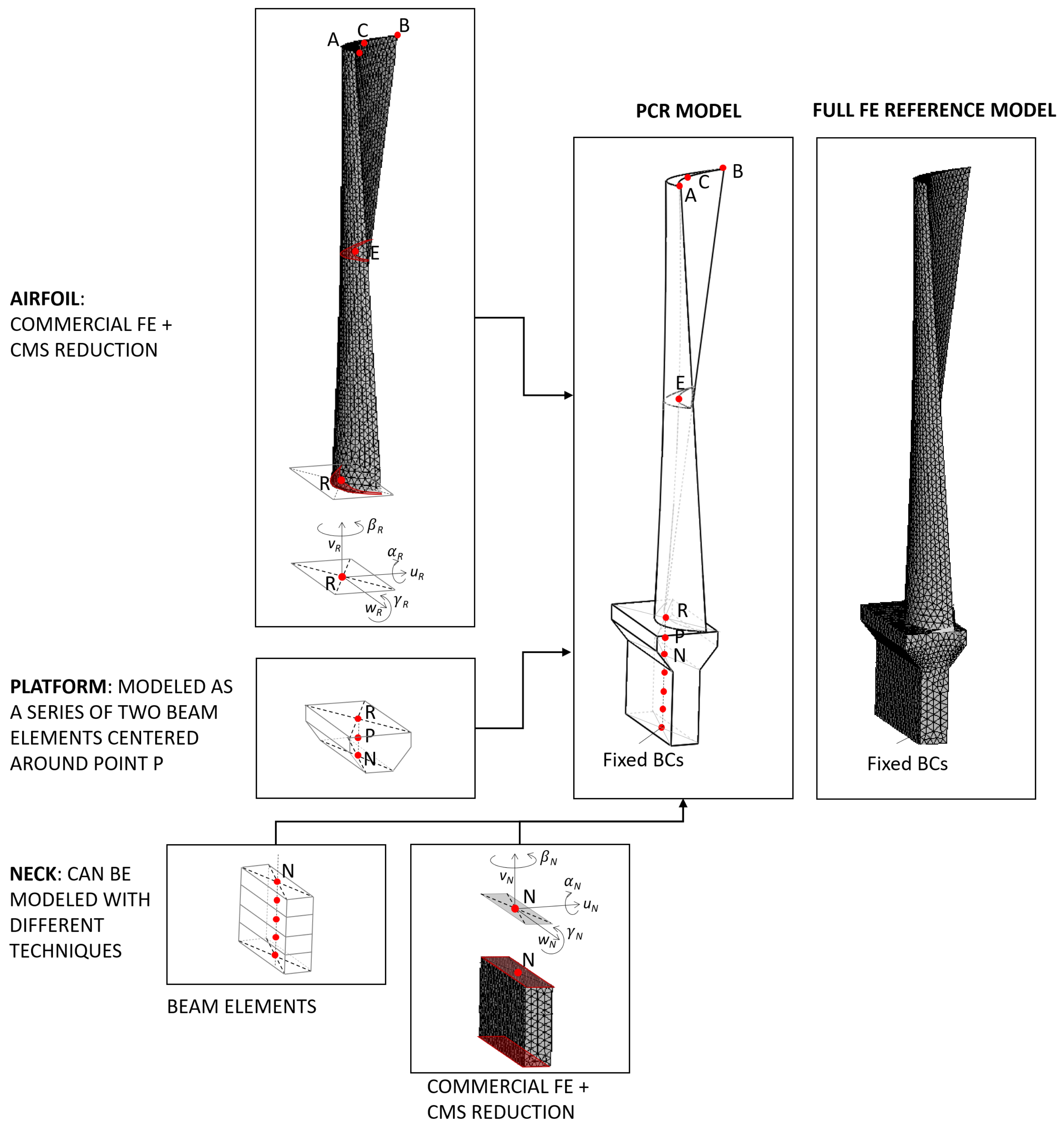
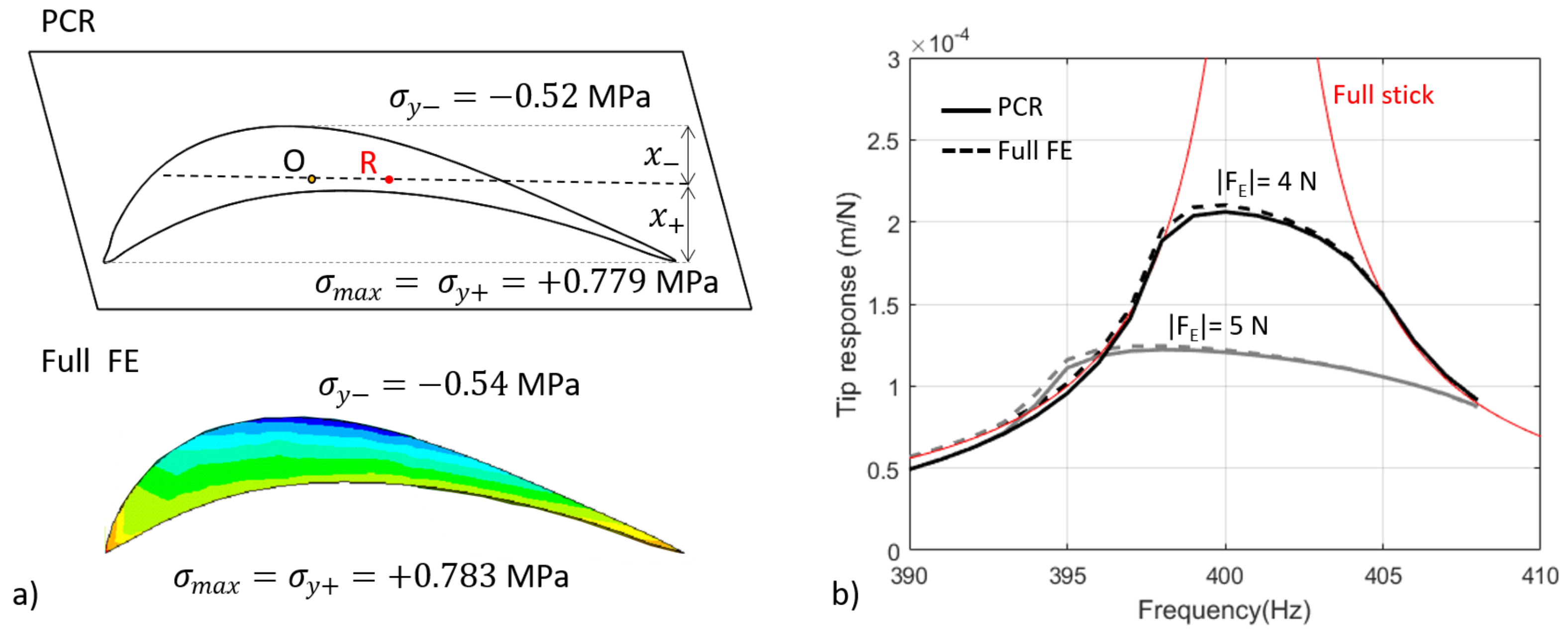
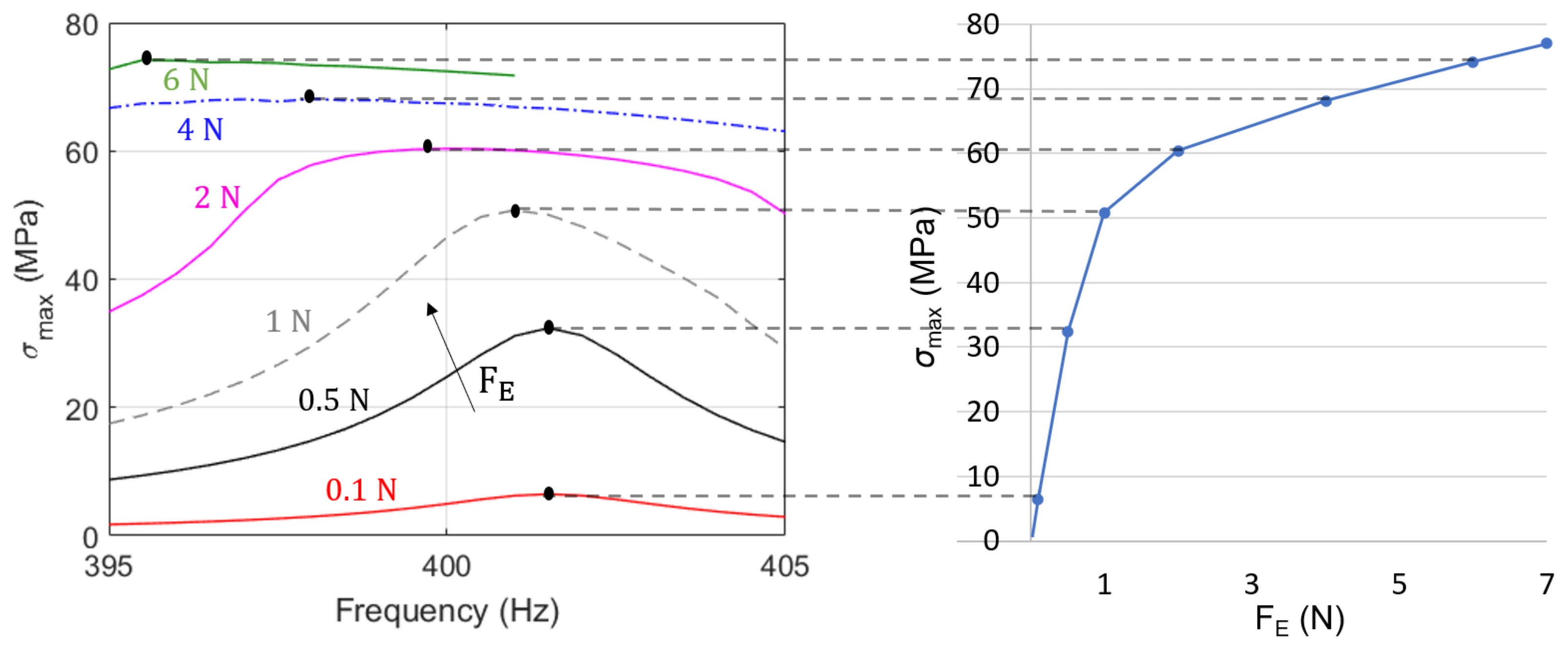
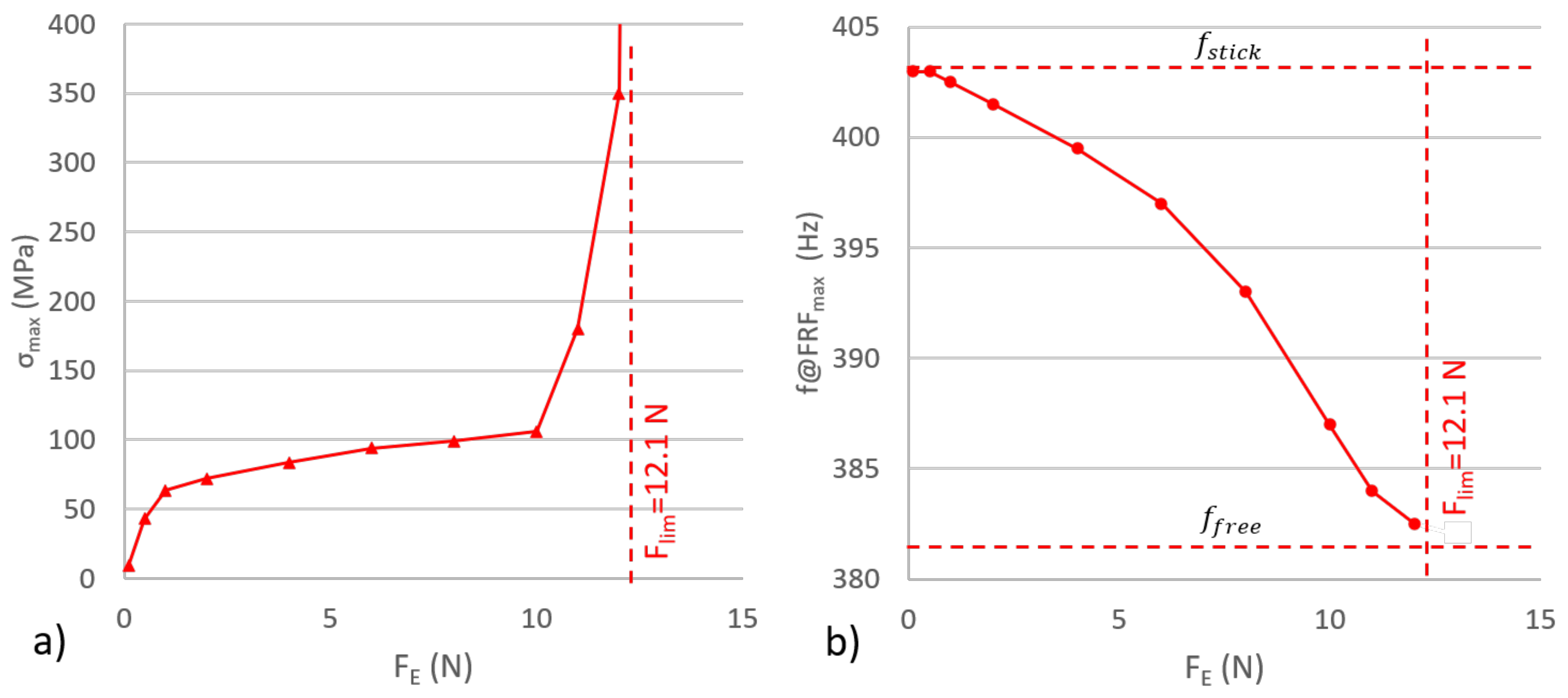
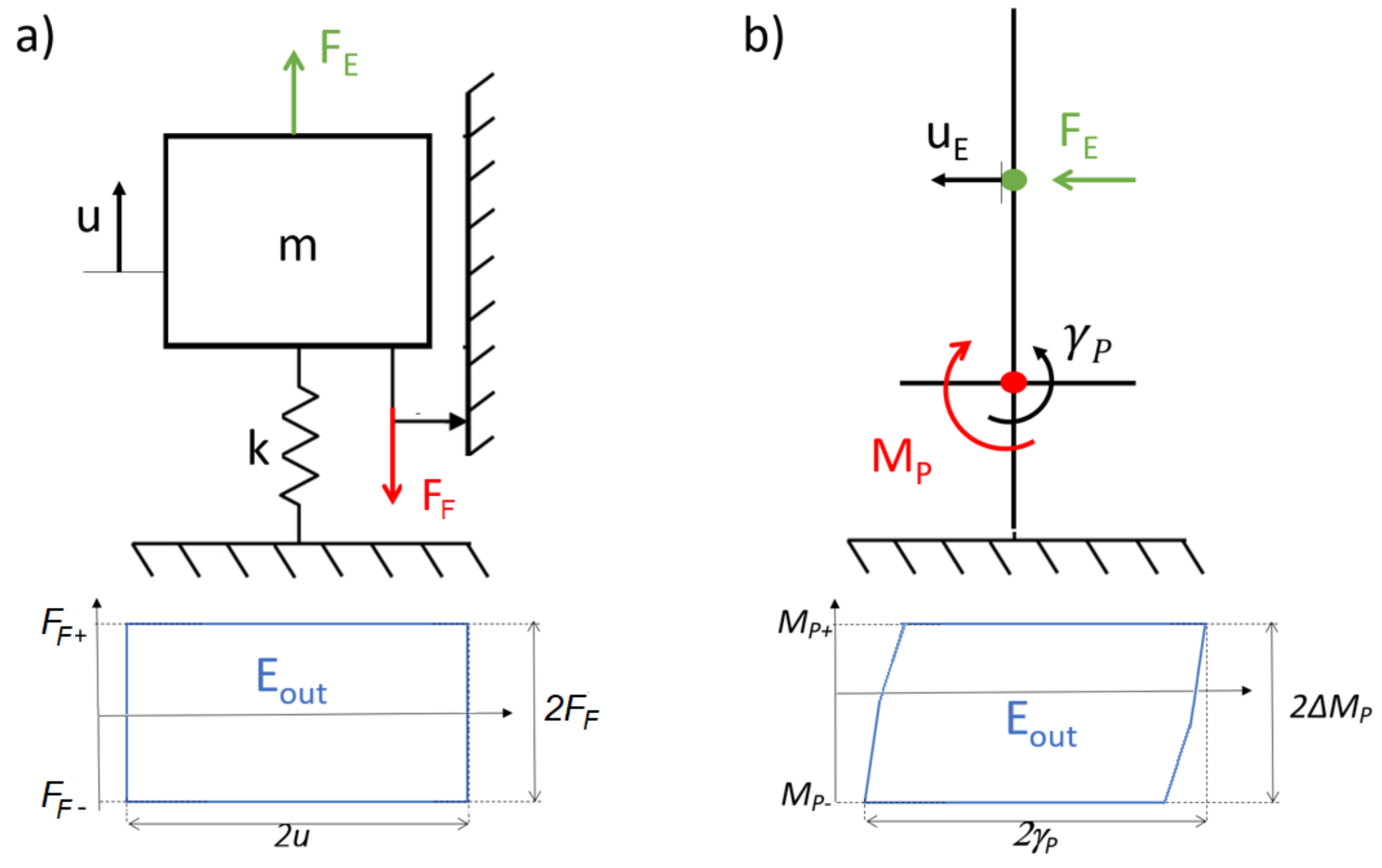
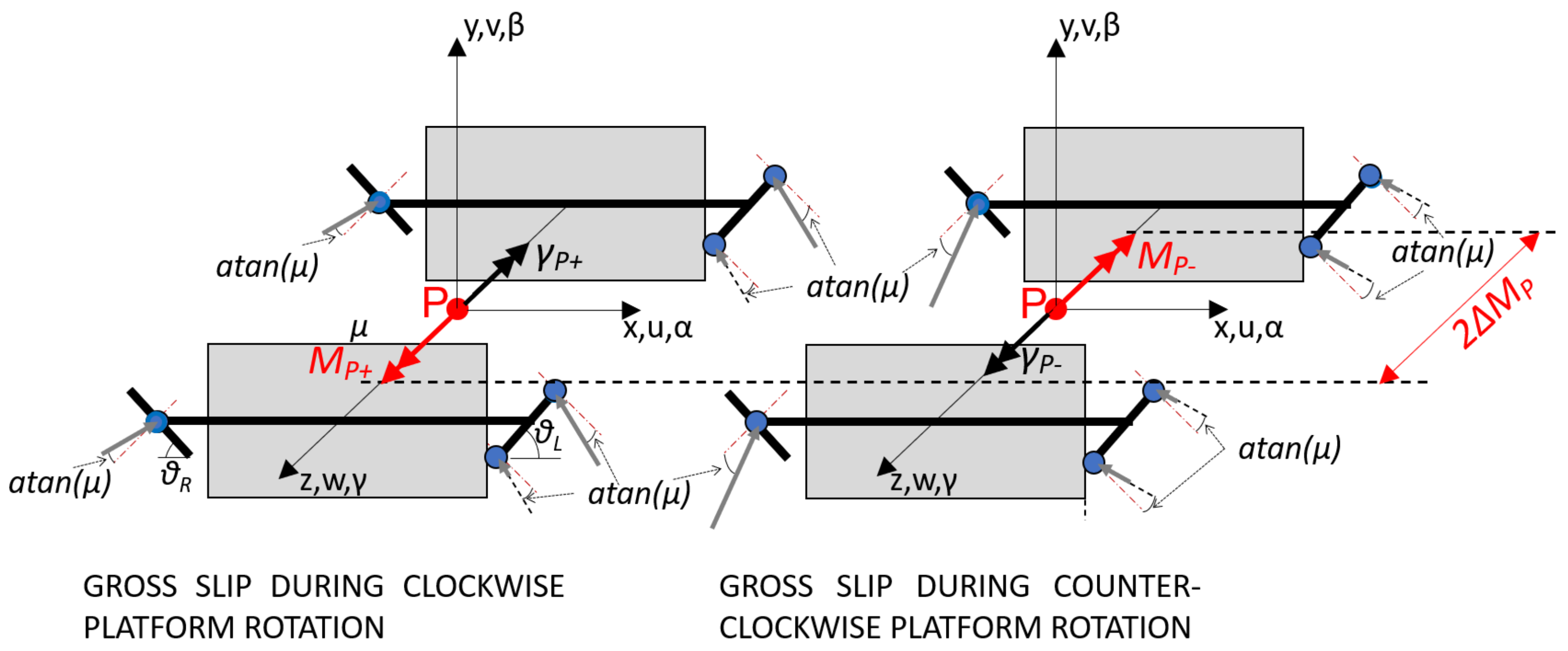


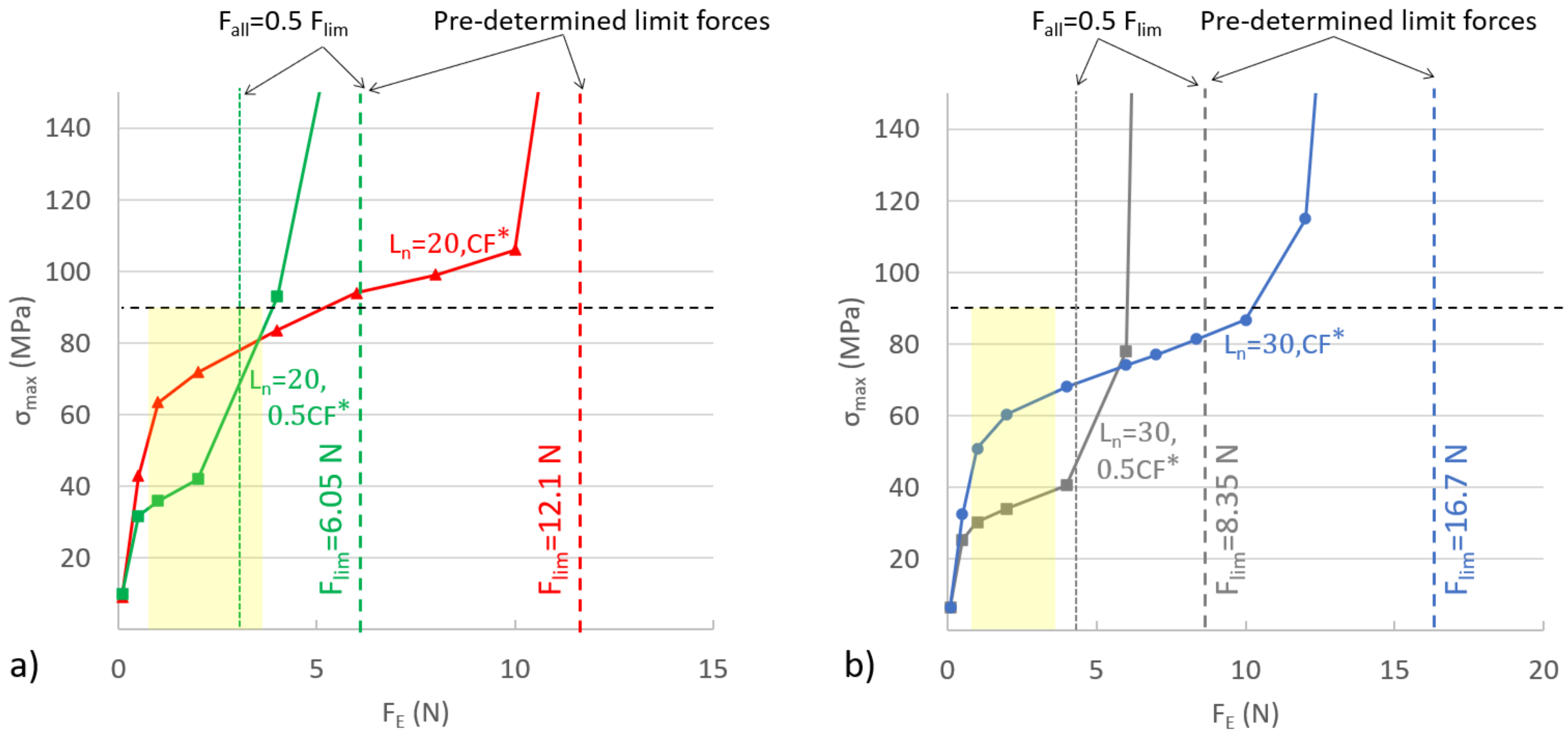
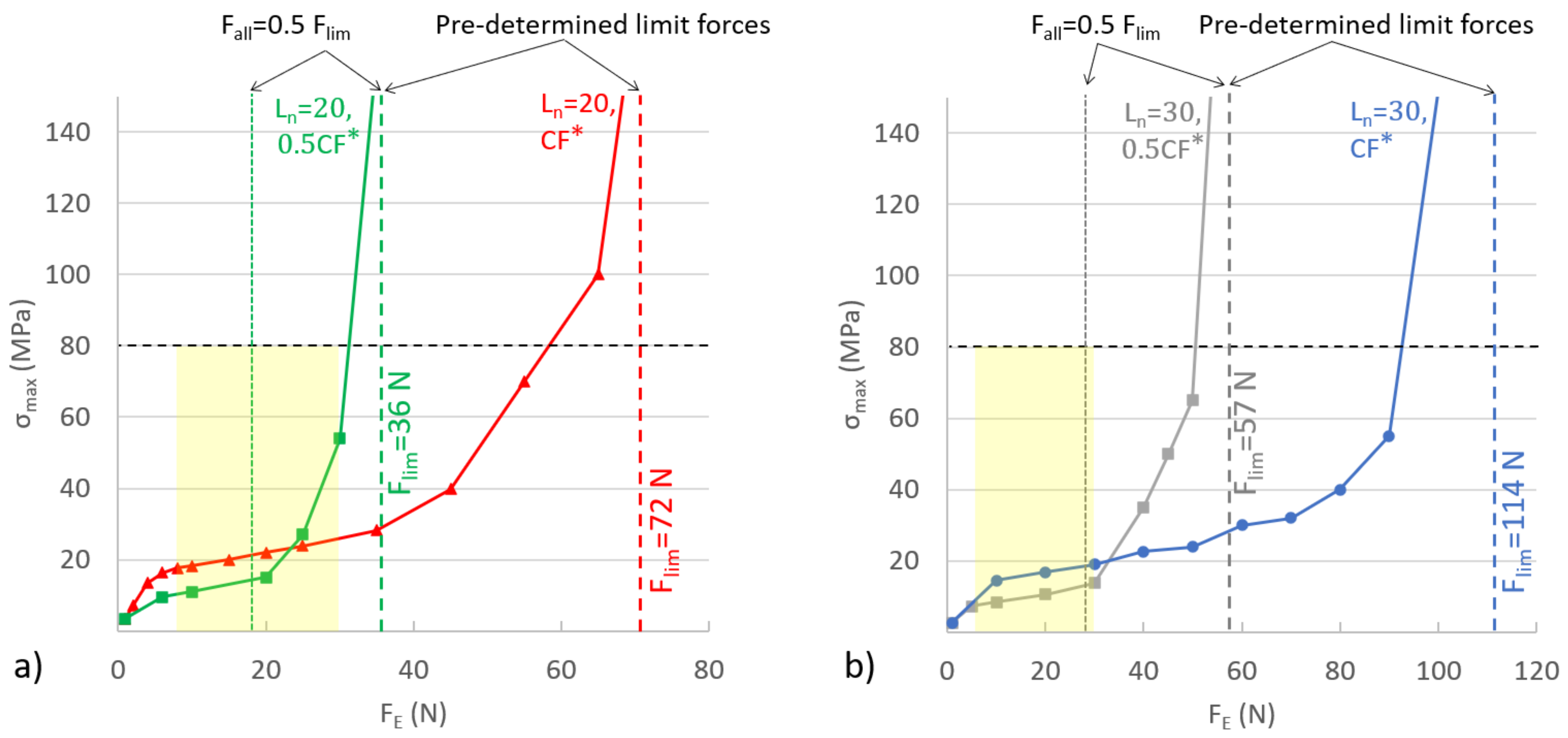

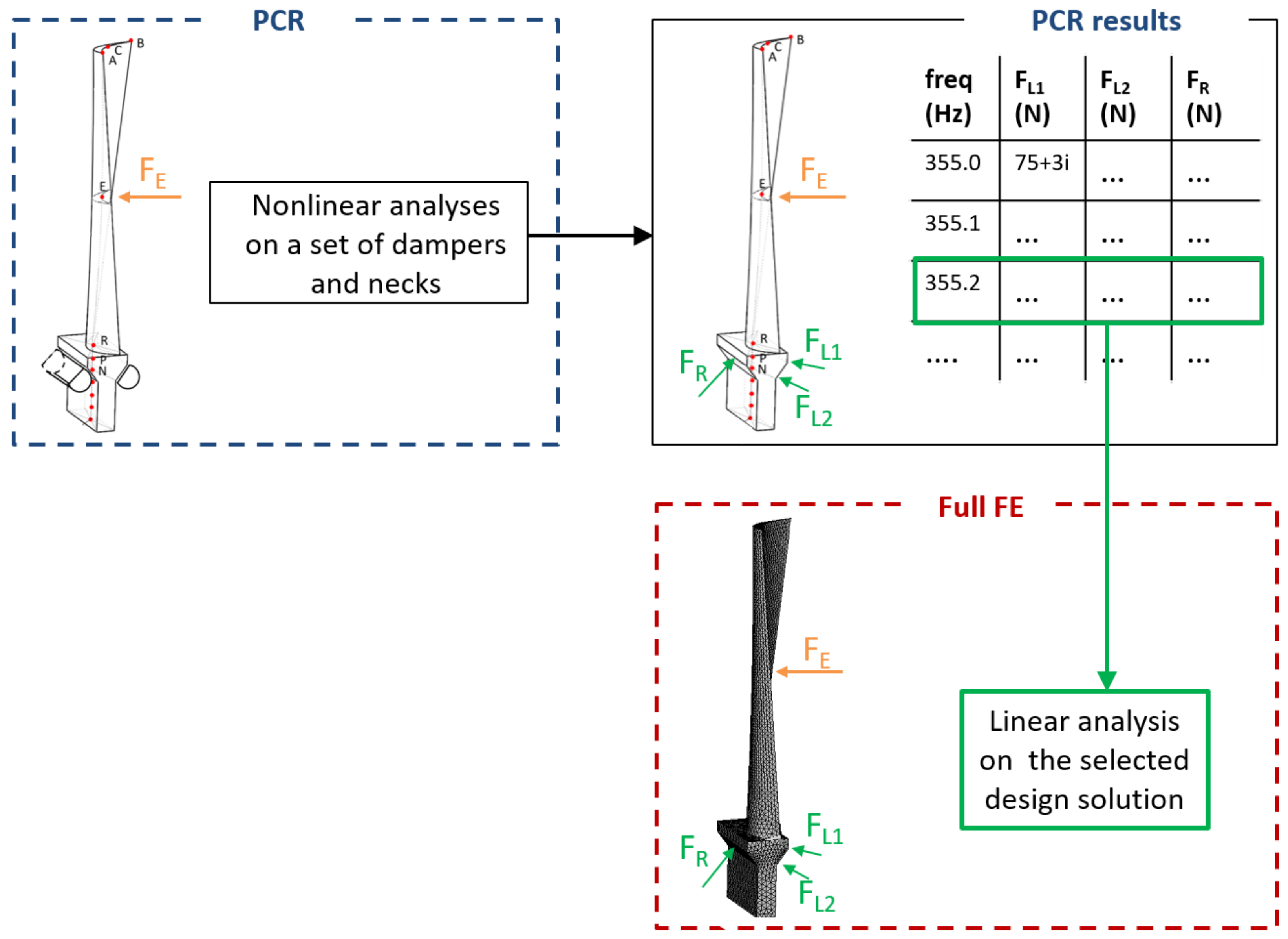
| Equivalence Indicator | Symbol | Full FE | PCR |
|---|---|---|---|
| (dyn.) Resonance Frequency | (Hz) | 381.2 | 381.3 |
| (dyn.) Mode shape | 2.797 | 2.792 | |
| 3.065 | 3.061 | ||
| 2.948 | 2.943 | ||
| (rad/m) | |||
| (rad/m) | 2.407 | 2.402 | |
| (static) Platform rotation | (rad) | ||
| (static) Airfoil tip displacement at point C | (m) | ||
| (static) Max. stress at airfoil “root” | (MPa) | 0.783 | 0.779 |
| Parameter | Blade A | Blade B |
|---|---|---|
| 20 mm | 20 mm | |
| 10 mm | 15 mm | |
| 120 mm | 400 mm | |
| - | 25 mm | |
| - | 35 mm | |
| 8 mm | - | |
| b | 45 mm | 180 mm |
| 900 N | 4000 N | |
| 381 Hz | 211 Hz | |
| 0.4 m/rad | 1.2 m/rad |
| Blade A | Blade B | Comments | |
|---|---|---|---|
| Material | René 41 | René 80 | |
| Airfoil mass | 0.12 kg | 4.17 kg | |
| Airfoil root area | 119 mm2 | 2707 mm2 | |
| Mean radius | 320 mm | 530 mm | |
| Mean blade speed | 198 m/s | 198 m/s | |
| Rotation speed | 6000 rpm | 3600 rpm | |
| Temperature | 650 °C | 450 °C | |
| Number of blades | 44 | 33 | |
| Root chord | 40 mm | 160 mm | |
| Mean pitch | 45 mm | 110 mm | |
| Blade circumf. force | 60 N | 490 N | |
| Blade bending force | 73 N | 590 N | |
| 1% bend. force amplitude | 0.73 N | 5.9 N | Alternating comp. |
| 5% bend. force amplitude | 3.5 N | 30 N | Alternating comp. |
| Mass radius | 296 mm | 454 mm | |
| Centrifugal force | 14 kN | 27 kN | |
| Nominal root stress | 120 MPa | 100 MPa | Mean on section |
| Ultimate stress | 1060 MPa | 940 MPa | At temperature |
| Yield stress | 810 MPa | 680 MPa | At temperature |
| cycl. fatigue limit | 205 MPa | 185 MPa | Alternating stress |
| Stress intens. factor Kf ≈ | 1.5 | 1.5 | At airfoil root fillet |
| cycl. fatigue limit | 185 MPa | 165 MPa | At mean root stress |
| Allow bend stress | 90 MPa | 80 MPa | Nominal at root |
Publisher’s Note: MDPI stays neutral with regard to jurisdictional claims in published maps and institutional affiliations. |
© 2021 by the authors. Licensee MDPI, Basel, Switzerland. This article is an open access article distributed under the terms and conditions of the Creative Commons Attribution (CC BY) license (https://creativecommons.org/licenses/by/4.0/).
Share and Cite
Gastaldi, C.; Gola, M.M. A Method to Minimize the Effort for Damper–Blade Matching Demonstrated on Two Blade Sizes. Appl. Sci. 2021, 11, 5171. https://doi.org/10.3390/app11115171
Gastaldi C, Gola MM. A Method to Minimize the Effort for Damper–Blade Matching Demonstrated on Two Blade Sizes. Applied Sciences. 2021; 11(11):5171. https://doi.org/10.3390/app11115171
Chicago/Turabian StyleGastaldi, Chiara, and Muzio M. Gola. 2021. "A Method to Minimize the Effort for Damper–Blade Matching Demonstrated on Two Blade Sizes" Applied Sciences 11, no. 11: 5171. https://doi.org/10.3390/app11115171
APA StyleGastaldi, C., & Gola, M. M. (2021). A Method to Minimize the Effort for Damper–Blade Matching Demonstrated on Two Blade Sizes. Applied Sciences, 11(11), 5171. https://doi.org/10.3390/app11115171







